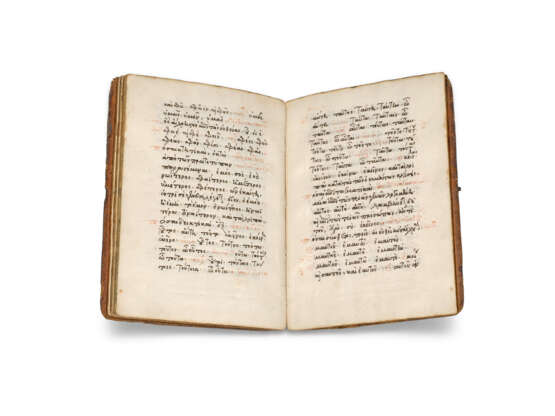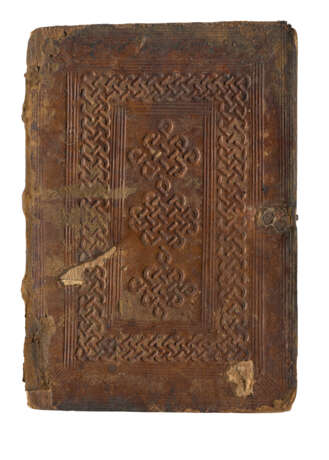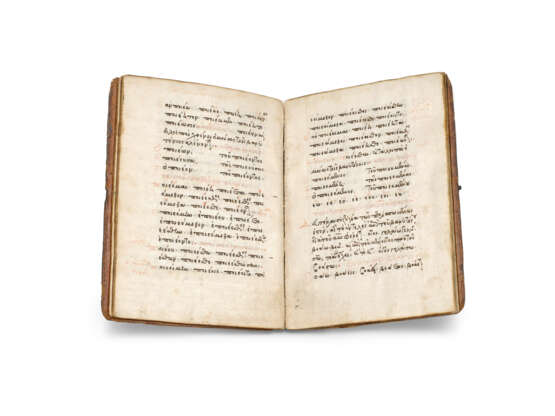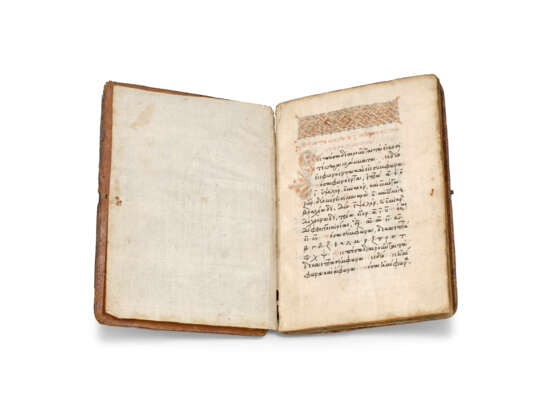ID 1349667
Lot 18 | Manuel Chrysoloras (c.1350-1415)
Estimate value
£ 15 000 – 20 000
Erotemata, in Greek, decorated manuscript on paper [Italy, ?Milan, final quarter 15th century]
A rare copy of the Greek Donatus, or the elementary Greek grammar composed by the Byzantine Greek classical scholar, humanist, philosopher, professor, and translator Manuel Chrysoloras (c.1350-1415), written by the scribe Damilas, in a contemporary Italian binding.
164 x 111mm. i+31 leaves, collation: 1-28, 37(of 8, lacking viii), 48, gathering signatures survive, 19 lines written in a fine, upright Greek minuscule by Demetrios of Crete, also known as Damilas, written space: 115 x 74mm, the text opening with a coloured interlace headpiece and a large initial in red and blue (lacking one leaf after f.23, some thumbing and marginal spotting). Bound in contemporary ?Milanese blind-stamped goatskin over thin wooden boards (a few losses to the upper cover, edges scuffed, lacking clasp, binding a little loose).
Provenance:
(1) The script of the present manuscript has been attributed by Konstantinos Sp. Staikos to the scribe and calligraphist Demetrios of Crete, also known as Damilas, active in Milan, Rome and Florence in the final quarter of the 15th century and known for having designed and cut the punches of the first book entirely printed in Greek, the famed 1476 Milanese Laskaris.
(2) Later ?19th-century inscriptions '2285' and '15' on inside upper and lower boards.
Contents: Erotemata, in the abridged version, ff.1-31.
The Erotemata, so-called because it was arranged according to the traditional 'erotematic' method of questions and answers, was without exception the most influential and popular Greek grammatical textbook of the Italian Renaissance. It was, in fact, the first basic Greek grammar in use in Western Europe, published in 1484 and widely reprinted, and enjoying considerable success not only among Chrysoloras' pupils in Florence, but also among leading humanists: it was studied by Thomas Linacre at Oxford and by Erasmus at Cambridge. The grammar has a very complex textual transmission, with the simultaneous circulation of the original 'full' version, and the more widespread and popular abridged text, as found in the present manuscript, written between 1417-1418 by Chrysoloras' pupil Guarino da Verona (1374-1460). Numerous 'contaminated' versions, mingling the abridgment of Guarino and the full version of Chrysoloras are recorded. The oldest extant copy in the full version is generally regarded to be Rome, BAV, Vat. Pal. Gr.116.
The present manuscript of the abridged version is contemporaneous with the text's first appearance in print. It rarely appears on the market.
| Place of origin: | Greece, Europe |
|---|---|
| Auction house category: | Medieval & renaissance manuscripts, Books and manuscripts |
| Place of origin: | Greece, Europe |
|---|---|
| Auction house category: | Medieval & renaissance manuscripts, Books and manuscripts |
| Address of auction |
CHRISTIE'S 8 King Street, St. James's SW1Y 6QT London United Kingdom | |
|---|---|---|
| Preview |
| |
| Phone | +44 (0)20 7839 9060 | |
| Buyer Premium | see on Website | |
| Conditions of purchase | Conditions of purchase |






